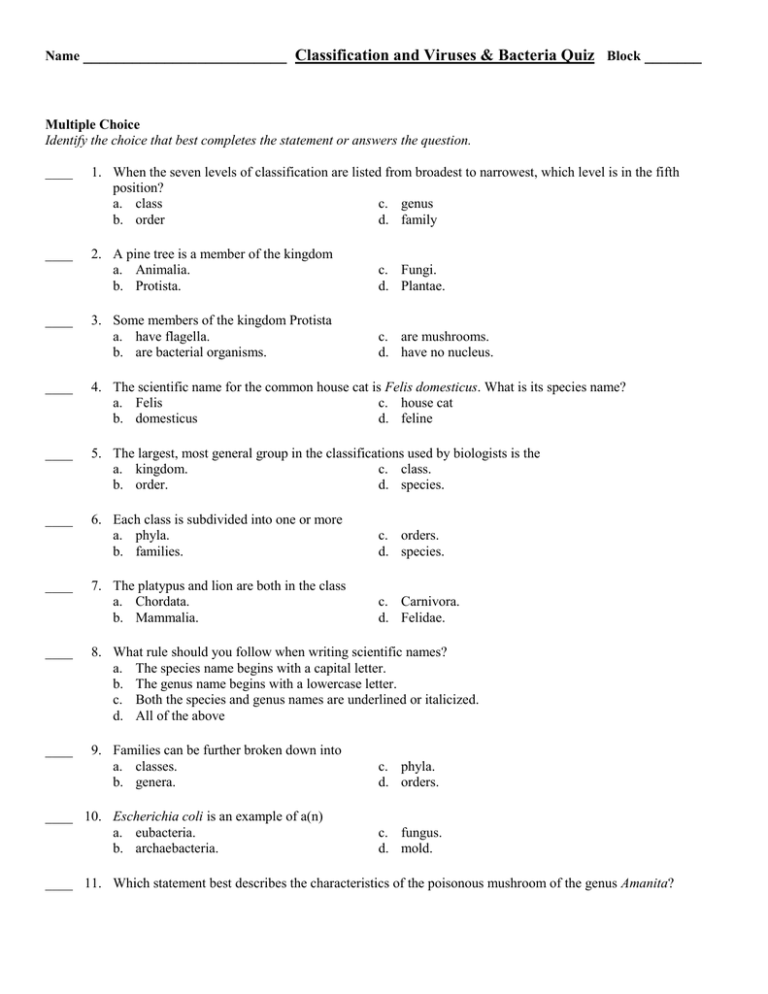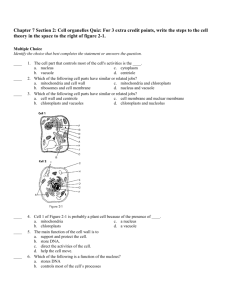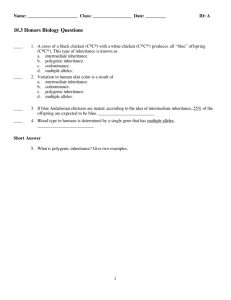Classification and Viruses & Bacteria Answer Section
advertisement

Name _________________________ Classification and Viruses & Bacteria Quiz Block _______ Multiple Choice Identify the choice that best completes the statement or answers the question. ____ 1. When the seven levels of classification are listed from broadest to narrowest, which level is in the fifth position? a. class c. genus b. order d. family ____ 2. A pine tree is a member of the kingdom a. Animalia. b. Protista. c. Fungi. d. Plantae. 3. Some members of the kingdom Protista a. have flagella. b. are bacterial organisms. c. are mushrooms. d. have no nucleus. ____ ____ 4. The scientific name for the common house cat is Felis domesticus. What is its species name? a. Felis c. house cat b. domesticus d. feline ____ 5. The largest, most general group in the classifications used by biologists is the a. kingdom. c. class. b. order. d. species. ____ 6. Each class is subdivided into one or more a. phyla. b. families. c. orders. d. species. 7. The platypus and lion are both in the class a. Chordata. b. Mammalia. c. Carnivora. d. Felidae. ____ ____ 8. What rule should you follow when writing scientific names? a. The species name begins with a capital letter. b. The genus name begins with a lowercase letter. c. Both the species and genus names are underlined or italicized. d. All of the above ____ 9. Families can be further broken down into a. classes. b. genera. ____ 10. Escherichia coli is an example of a(n) a. eubacteria. b. archaebacteria. c. phyla. d. orders. c. fungus. d. mold. ____ 11. Which statement best describes the characteristics of the poisonous mushroom of the genus Amanita? Name _________________________ Classification and Viruses & Bacteria Quiz Block _______ a. b. c. d. It performs photosynthesis. It is a single-celled organism. It eats insects. It gets nutrients by decomposing matter with digestive juices. ____ 12. Animals are different from fungi, plants, and most protists in that animal cells lack a. organelles. c. cell walls. b. nuclei. d. cell membranes. ____ 13. Linnaeus’s classification system is called a. taxonomy. b. taxidermy. c. taxation. d. the dichotomous system. ____ 14. Corals, spiders, and rodents all belong to the kingdom a. Animalia. c. Mammalia. b. Protista. d. Fungi. Examine the illustration below and answer the questions that follow. ____ 15. Organism D in the picture above is classified in the kingdom a. Fungi. c. Animalia. b. Protista. d. Plantae. ____ 16. Organism C in the picture above is classified in the kingdom a. Fungi. c. Animalia. b. Protista. d. Plantae. ____ 17. Bacteria are different from all other living things because they lack a. organelles. c. cell walls. b. nuclei. d. cell membranes. ____ 18. In the lytic cycle a. the host cell is destroyed. b. the host cell destroys the virus. ____ 19. Cyanobacteria a. are consumers. b. are parasites. ____ 20. Viruses a. are about the same size as bacteria. b. have nuclei. c. the host cell becomes a virus. d. the host cell undergoes cell division. c. contain chlorophyll. d. are decomposers. c. can reproduce only within a host cell. d. don’t infect plants. Name _________________________ Classification and Viruses & Bacteria Quiz Block _______ ____ 21. Which of the following is NOT a true statement about viruses? a. Viruses do not have cytoplasm or a nucleus. b. Viruses obtain nutrients from their hosts’ cells. c. Viruses contain genetic material. d. Viruses can infect bacteria. ____ 22. Which of the following statements best describes bacteria? a. Bacteria are single-celled organisms that do not have nuclei. b. Bacteria are single-celled organisms that have nuclei. c. Bacteria are multi-celled organisms that have nuclei. d. Bacteria are multi-celled organisms that do not have nuclei. ____ 23. In Latin, the word flagellum means a. "whip." b. "corkscrew." c. "hair." d. "propeller." ____ 24. Flagella help bacteria to a. catch food. b. take in water. c. absorb oxygen. d. move around. ____ 25. Bacilli are bacteria that are a. spherical. b. rod-shaped. c. spiral-shaped. d. cubic. ____ 26. ____ obtain nutrients from other organisms. a. Decomposers b. Consumers c. Parasites d. all of the above ____ 27. More than 75 percent of the air is made up of a. carbon dioxide. b. oxygen. c. nitrogen. d. methane. ____ 28. The bubonic plaque that killed one-third of Europe's population in the mid-1300s was caused by a. pathogenic bacteria. c. archaebacteria. b. viruses. d. cyanobacteria. ____ 29. Today, many bacterial diseases can be prevented with a. antibiotics. c. vaccines. b. insulin. d. endospores. ____ 30. The common cold is caused by a. pathogenic bacteria. c. Escherichia coli. b. a virus. d. lactic-acid bacteria. ____ 31. Which of the following is NOT a shape of viruses? a. crystals c. cylinders b. spacecraft d. spirilla Name _________________________ Classification and Viruses & Bacteria Quiz Block _______ ____ 32. Viruses that attack only bacteria are shaped like a. crystals. c. cylinders. b. spacecraft. d. spheres. ____ 33. A virus reproduces through a. the lysogenic cycle. b. the lytic cycle. c. binary fission. d. sexual reproduction. ____ 34. Viruses are not considered to be living because they do not a. eat. c. breathe. b. grow. d. All of the above ____ 35. Bacteria obtain energy through a. photosynthesis. b. "feeding" on dead animals, plants, and wastes. c. their host organisms. d. All of the above Completion Complete each statement. 36. Archaebacteria and eubacteria are ____________________. (prokaryotes or eukaryotes) 37. Members of the kingdom ____________________ include such organisms as the mold that grows on bread. (Fungi or Plantae) 38. ____________________ are thought to have existed on Earth at least 3 billion years. (Archaebacteria or Eubacteria) 39. Plants use the sun's energy to make sugar by a process called ____________________. 40. A(n)____________________ is a thick protective membrane that contains an inactive bacterium. (cocci or endospore) 41. Spherical bacteria are called ____________________. (cocci, bacilli) 42. A ____________________ is a microscopic particle that invades a cell and often destroys it. 43. The ____________________ cycle occurs when a virus infects a living cell and turns it into a virus factory. (decomposition, lytic) Name _________________________ Classification and Viruses & Bacteria Quiz Block _______ Short Answer 44. What characteristics do baboons have that lemurs do not have? Explain your answer. 45. Use the following terms to complete the concept map below: producers, consumers, Fungi, nutrients, Plantae, digestive juices. 46. How are viruses like and unlike living things? Name _________________________ Classification and Viruses & Bacteria Quiz Block _______ Classification and Viruses & Bacteria Answer Section MULTIPLE CHOICE 1. 2. 3. 4. 5. 6. 7. 8. 9. 10. 11. 12. 13. 14. 15. 16. 17. 18. 19. 20. 21. 22. 23. 24. 25. 26. 27. 28. 29. 30. 31. 32. 33. 34. 35. ANS: ANS: ANS: ANS: ANS: ANS: ANS: ANS: ANS: ANS: ANS: ANS: ANS: ANS: ANS: ANS: ANS: ANS: ANS: ANS: ANS: ANS: ANS: ANS: ANS: ANS: ANS: ANS: ANS: ANS: ANS: ANS: ANS: ANS: ANS: D D A B A C B C B A D C A A A B B A C C B A A D B D C A C B D B B D D COMPLETION 36. ANS: prokaryotes PTS: PTS: PTS: PTS: PTS: PTS: PTS: PTS: PTS: PTS: PTS: PTS: PTS: PTS: PTS: PTS: PTS: PTS: PTS: PTS: PTS: PTS: PTS: PTS: PTS: PTS: PTS: PTS: PTS: PTS: PTS: PTS: PTS: PTS: PTS: 1 1 1 1 1 1 1 1 1 1 1 1 1 1 1 1 1 1 1 1 1 1 1 1 1 1 1 1 1 1 1 1 1 1 1 DIF: DIF: DIF: DIF: DIF: DIF: DIF: DIF: DIF: DIF: DIF: DIF: DIF: DIF: DIF: DIF: DIF: DIF: DIF: DIF: DIF: DIF: DIF: DIF: DIF: DIF: DIF: DIF: DIF: DIF: DIF: DIF: DIF: DIF: DIF: I I I I I I I I I I I I I II II II I I I I I I I I I I I I I I I I I I I OBJ: OBJ: OBJ: OBJ: OBJ: OBJ: OBJ: OBJ: OBJ: OBJ: OBJ: OBJ: OBJ: OBJ: OBJ: OBJ: OBJ: OBJ: OBJ: OBJ: OBJ: OBJ: OBJ: OBJ: OBJ: OBJ: OBJ: OBJ: OBJ: OBJ: OBJ: OBJ: OBJ: OBJ: OBJ: 9-1.2 9-2.2 9-2.2 9-1.2 9-1.1 9-1.1 9-1.2 9-1.3 9-1.2 9-2.1 9-2.2 9-2.2 9-1.3 9-2.2 9-2.2 9-2.2 9-2.2 10-3.3 10-1.3 10-3.3 10-3.1 10-1.1 10-1.1 10-1.1 10-1.1 10-1.3 10-2.1 10-2.3 10-2.3 10-3.1 10-3.2 10-3.2 10-3.3 10-3.1 10-2.1 Name _________________________ Classification and Viruses & Bacteria Quiz Block _______ PTS: 1 37. ANS: Fungi DIF: I OBJ: 9-2.1 PTS: 1 DIF: I 38. ANS: Archaebacteria OBJ: 9-2.2 PTS: 1 DIF: I 39. ANS: photosynthesis OBJ: 9-2.2 PTS: 1 40. ANS: endospore DIF: I OBJ: 9-2.1 PTS: 1 41. ANS: cocci DIF: I OBJ: 10-1.1 PTS: 1 42. ANS: virus DIF: I OBJ: 10-1.1 PTS: 1 43. ANS: lytic DIF: I OBJ: 10-3.1 DIF: I OBJ: 10-3.3 PTS: 1 SHORT ANSWER 44. ANS: Color vision; color vision appears on the diagram after lemurs have branched off. PTS: 1 45. ANS: DIF: II OBJ: 9-1.2 Name _________________________ Classification and Viruses & Bacteria Quiz Block _______ PTS: 1 DIF: II OBJ: 9-2.2 46. ANS: Like living things, viruses contain protein and nucleic acids. But unlike living things, viruses do not eat, grow, breathe, or perform other functions. PTS: 1 DIF: I OBJ: 10-3.1







